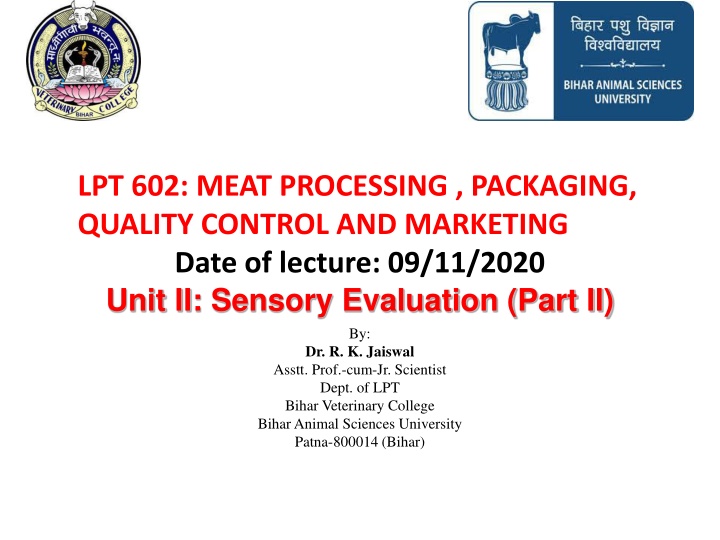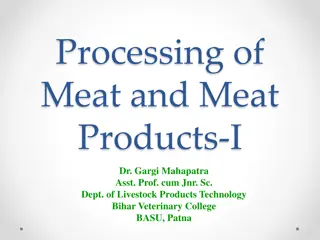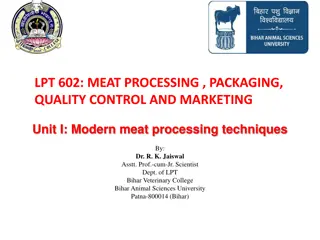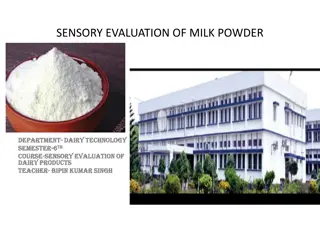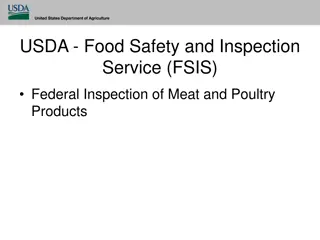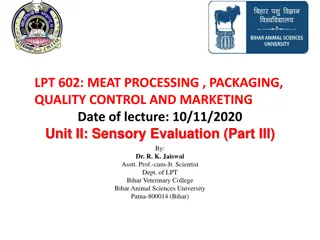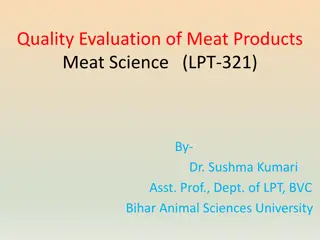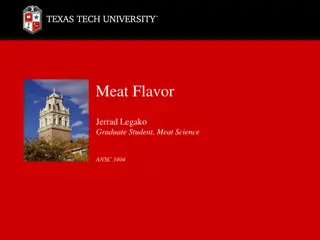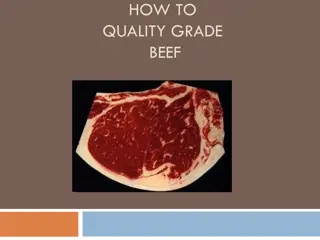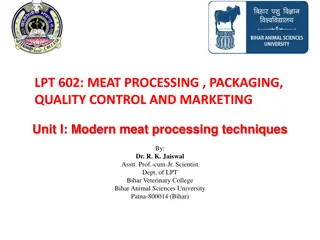Sensory Evaluation of Meat: Colour, Juiciness, Flavour, and Texture
Sensory evaluation of meat plays a crucial role in determining its quality. Colour, juiciness, flavour, and texture are key attributes assessed by consumers. The colour of meat is influenced by factors such as myoglobin content and cooking methods. Juiciness reflects the water holding capacity of meat, affected by various factors like ageing and animal handling. Flavour encompasses a range of sensations, including odour, taste, and texture, contributing to the overall sensory experience of meat products.
Download Presentation

Please find below an Image/Link to download the presentation.
The content on the website is provided AS IS for your information and personal use only. It may not be sold, licensed, or shared on other websites without obtaining consent from the author.If you encounter any issues during the download, it is possible that the publisher has removed the file from their server.
You are allowed to download the files provided on this website for personal or commercial use, subject to the condition that they are used lawfully. All files are the property of their respective owners.
The content on the website is provided AS IS for your information and personal use only. It may not be sold, licensed, or shared on other websites without obtaining consent from the author.
E N D
Presentation Transcript
LPT 602: MEAT PROCESSING , PACKAGING, QUALITY CONTROL AND MARKETING Date of lecture: 09/11/2020 Unit II: Sensory Evaluation (Part II) By: Dr. R. K. Jaiswal Asstt. Prof.-cum-Jr. Scientist Dept. of LPT Bihar Veterinary College Bihar Animal Sciences University Patna-800014 (Bihar)
Sensory attributes of meat and meat products Colour Juiciness Flavour Texture
Colour Pigment of muscle, myoglobin : colour of meat Appearance of meat surface to the consumer--not on the quantity of myoglobin present but on its chemical state Variations in the quantity of myoglobin in the muscles are the activity of the muscle during life Differences may also arises due to species, breed, sex, age type of muscle and training/exercise In fresh meat, before cooking, the most important chemical form is oxymyoglobin (Ferrous form). Occurs on the surface--bright red in colour. Colour of myoglobin is purplish red
Consumer relates the appearance and colour of meat to safety and healthiness Consumer relates the colour of cooked meat to doneness. Final colour of cooked meat is dependent to the pigment changes brought about by temperature, time and method of cooking When meat is cooked there is gradual change of colour from dark red or pink to a lighter shade and finally at higher temperatures to grey or brown colour Pressure-cooked or boiled meat will discern a grey colour whereas roasted; broiled or canned meat turns brown Brown colour of thoroughly cooked meat is due to denaturation of heme pigments and polymerization of some proteins and fats Colour of fresh pork, mutton and buffalo fat is white and undergoes very little change during cooking.
Juiciness Juiciness perceived during sensory evaluation has two components: Initial purge Sustained juiciness due to marbling Juiciness is also influenced state of rigor of the meat, handling of the animal peri-slaughter, manner in which meat is handled (cold shortening, thaw rigor), ageing etc. Juiciness is a reflection of water holding capacity (WHC) of meat.
Flavour Flavour is a complex sensation. It involves odour, taste, texture, temperature and pH. Of these the odour is the most important. It is sensed jointly by the oral and olfactory senses. The odour and taste of cooked meat arise from water or fat-soluble precursors and by the liberation of volatile substances that exist in the meat. Meat samples should be smelled first followed by tasting for a rational and sound flavour perception of several volatile components present in meat. These components are significantly marked when meat is cooked. Flavour has been shown to have a profound effect on the overall acceptability of meat products.
Duration and temperature of cooking influences the nature and intensity of odour and taste in meat. This is a gradual loss of flavour during storage; this may occur even in frozen conditions. Flavour of fresh raw meat is weak, salty and serum-like. Fresh meat fat also has almost indistinct taste and odour. It is during cooking that flavour get pronounced and become meaty. Fresh cooked beef is metallic and astringent. Veal flavour is sweet and flat. Pork flavour is regarded sweet and bland. Sex odour is more pronounced in male.
Pork from boar has defined piggary odour or boar taint. During long-term storage, most meat develop rancid odour due to fat oxidation. It may be muttony, tallowy for beef and stale, cheesy or fishy for pork. In case the meat is spoiled during storage, it emanates putrid odour due to protein decomposition. When cooked meat is stored for along time, myoglobin catalysed fat oxidation takes place yielding a distinct warmed-over flavour. Canning imparts canned-meat flavour to meat products due to severe heat treatment.
Texture Texture is one of the most important eating quality attributes in the acceptance of meat. The overall impression of texture is perceived by the senses of touch, sight and hearing. Texture is a direct consequence of the grain in fresh meat.
